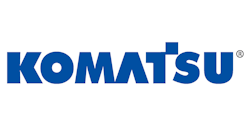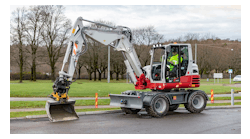Today’s operators are concerned about hydraulic system performance in two main areas, first and foremost productivity, says Jeff Bauer, senior engineer, hydraulic product verification for John Deere Construction & Forestry. “This is what ultimately gets the job done and puts the food on the table. The better the productivity, the more jobs can be done in a day, a week, or a year, which puts a lot more food on the table.”
The second area is efficiency. A more efficient system can produce the same work with less fuel usage. Lower fuel usage reduces operating cost. “There is a balance in performance between productivity and efficiency,” continues Bauer. “Machines that excel in both areas are highly sought-after.”
Today’s operators are concerned about hydraulic system performance in two main areas, first and foremost productivity, says Jeff Bauer, senior engineer, hydraulic product verification for John Deere Construction & Forestry. “This is what ultimately gets the job done and puts the food on the table. The better the productivity, the more jobs can be done in a day, a week, or a year, which puts a lot more food on the table.” The second area is efficiency. A more efficient system can produce the same work with less fuel usage. Lower fuel usage reduces operating cost. “There is a balance in performance between productivity and efficiency,” continues Bauer. “Machines that excel in both areas are highly sought-after.” [text_ad] Adding to both, advances in hydraulic technology provide ease of use. Changing attachments, tools, or buckets used to take either two people or several minutes, explains Bauer. “Now it can be done from the cab. Level grade used to be accomplished with stakes, tapes, and string. Today, it is done with site mapping and laser guidance, making it much more accurate and faster.” Because flow and pressure work together to increase the productivity of the unit and how efficient the unit will be when carrying high-demand attachments, the hydraulic pressure of a machine is important to consider. Curt Leair, rental accounts service manager for Terex Construction Americas, says it’s often overlooked in the purchase decision, especially the auxiliary hydraulics. “Most contactors are only concerned with the flow capabilities of the unit; they seldom consider the pressure and how this affects the overall performance of the machine and any attachments it will be operating. For example, buyers need to be sure that the pressure of the unit matches the specification of the attachment—too much flow can damage hydraulic drive motors and solenoids inside the attachment. And if the attachment does not have enough pressure, it will not perform correctly.” Only once the amount of pressure needed is established do buyers have to consider the flow and pressure as a combined force and how this will affect their productivity. By being able to calculate the hydraulic horsepower of the unit, buyers can then pick the best unit for maximum productivity. Calculating hydraulic horsepower is simple: take the GPM, or flow of the unit, and multiply it by the psi, or pressure, then divide that total by the constant, which is 1,714. Here’s an example to better illustrate: a unit with 45 GPM and a pressure of 3,800 psi would have a hydraulic horsepower of 99.7. “The most important thing is what the machine does for the customer,” sums up Gary Kassen, engineering director for hydraulics and pneumatics, CNH Industrial. Getting more work done and being more comfortable while doing it sells machines and is what operators and dealers are interested in, he believes. Highly skilled drivers will find the learning curve short with John Deere’s automation control software on certain earth grading equipment, which Bauer says will improve productivity while further enhancing ease of operation. Motor graders have an option called “cross-slope” that allows the operator to focus on one corner of the blade while the computer controls the other. “This allows for faster ground speed while grading, and also provides for a more accurate cut.” Hydraulic systems today are more efficient and higher performing due to increased flows and pressures, producing faster cycle times. They also provide versatility. Instead of dedicated machines that often sat unused, machines can easily swap attachments for more productivity. Mike Fitzgerald, loader product specialist for Bobcat emphasizes “The increased hydraulic performance allows customers to add specialized attachments for versatility,” He lists trenchers, planers, wheel saws, and brush and forestry cutters, all of which perform better with higher flows and pressures. “Customers can replace dedicated machines that may not have high utilization with a skid-steer or compact track loader and several attachments that increase their efficiency and profitability.”Adding to both, advances in hydraulic technology provide ease of use. Changing attachments, tools, or buckets used to take either two people or several minutes, explains Bauer. “Now it can be done from the cab. Level grade used to be accomplished with stakes, tapes, and string. Today, it is done with site mapping and laser guidance, making it much more accurate and faster.”
Because flow and pressure work together to increase the productivity of the unit and how efficient the unit will be when carrying high-demand attachments, the hydraulic pressure of a machine is important to consider. Curt Leair, rental accounts service manager for Terex Construction Americas, says it’s often overlooked in the purchase decision, especially the auxiliary hydraulics. “Most contactors are only concerned with the flow capabilities of the unit; they seldom consider the pressure and how this affects the overall performance of the machine and any attachments it will be operating. For example, buyers need to be sure that the pressure of the unit matches the specification of the attachment—too much flow can damage hydraulic drive motors and solenoids inside the attachment. And if the attachment does not have enough pressure, it will not perform correctly.”
Only once the amount of pressure needed is established do buyers have to consider the flow and pressure as a combined force and how this will affect their productivity. By being able to calculate the hydraulic horsepower of the unit, buyers can then pick the best unit for maximum productivity. Calculating hydraulic horsepower is simple: take the GPM, or flow of the unit, and multiply it by the psi, or pressure, then divide that total by the constant, which is 1,714. Here’s an example to better illustrate: a unit with 45 GPM and a pressure of 3,800 psi would have a hydraulic horsepower of 99.7.
“The most important thing is what the machine does for the customer,” sums up Gary Kassen, engineering director for hydraulics and pneumatics, CNH Industrial. Getting more work done and being more comfortable while doing it sells machines and is what operators and dealers are interested in, he believes.
Highly skilled drivers will find the learning curve short with John Deere’s automation control software on certain earth grading equipment, which Bauer says will improve productivity while further enhancing ease of operation. Motor graders have an option called “cross-slope” that allows the operator to focus on one corner of the blade while the computer controls the other. “This allows for faster ground speed while grading, and also provides for a more accurate cut.”
Hydraulic systems today are more efficient and higher performing due to increased flows and pressures, producing faster cycle times. They also provide versatility. Instead of dedicated machines that often sat unused, machines can easily swap attachments for more productivity. Mike Fitzgerald, loader product specialist for Bobcat emphasizes “The increased hydraulic performance allows customers to add specialized attachments for versatility,” He lists trenchers, planers, wheel saws, and brush and forestry cutters, all of which perform better with higher flows and pressures. “Customers can replace dedicated machines that may not have high utilization with a skid-steer or compact track loader and several attachments that increase their efficiency and profitability.”










